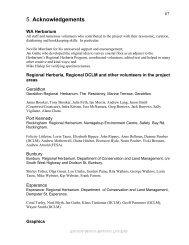Nuytsia 8: 3 (1998) - FloraBase
Nuytsia 8: 3 (1998) - FloraBase
Nuytsia 8: 3 (1998) - FloraBase
Create successful ePaper yourself
Turn your PDF publications into a flip-book with our unique Google optimized e-Paper software.
Paul G. Wilson, Helipterum: Part 1<br />
The classification that follows for a portion of the Helipterum complex in Australia attempts to<br />
associate closely related species and to segregate as distinct genera those species or groups of species<br />
that exhibit marked morphological discontinuity. In Rhodanthe I have not been successful in interpreting<br />
the phylogenetic significance of the varied morphological forms that are adopted by homologous<br />
organs. In the achene, for example, the pericarp and testa can have many different textures and structures<br />
(Short et al. 1989), yet to generically separate taxa that have dissimilar achenes can lead to the separation<br />
of species which otherwise have markedly similar florets and similar bract morphologies. For this reason<br />
I have adopted a sectional rank for taxa that may later be shown to deserve generic rank and which were<br />
sometimes so accorded by early 19th century taxonomists.<br />
I have not attempted to place all the genera of the 'Angiantheae’ sensu Bentham (1867) in context<br />
with those of the Helipterum complex but it is obvious that a close relationship often exists. This type<br />
of synoptic work will have to be done by others; my principal concern is to provide a classification that<br />
can be used for a 'Flora of Australia’ treatment and, from the pressure of time alone, many interesting<br />
phylogenetic avenues must remain unexplored.<br />
This paper considers the Rhodanthe, Hyalosperma and Triptilodiscus groups of species, most of<br />
which have, in general, been placed in Helipterum. These groups can be informally categorized as<br />
follows.<br />
Rhodanthe group: Inner involucral bracts with broad flat claws; anthers with fine filamentous tails;<br />
achenes with normal (mostly not thickened) duplex hairs. Species in this group, with the exception of<br />
Rhodanthe citrina, that have been examined, do not form ectomycorrhiza (Warcup 1990).<br />
Hyalosperma group: As above, however, achenes lacking normal duplex hairs but with 2-celled bulbous<br />
papillae that are frequently myxogenic; pappus shed entire. Species in this group that have been<br />
examined form ectomycorrhiza (Warcup op.cit.)<br />
Triptilodiscus group: Species in this group have achenes with 2-celled tooth-like trichomes and oblong<br />
or boat-shaped claws to the involucral bracts. Other characters suggest that the included genera may<br />
not be closely related and that the group is polyphyletic; this therefore becomes a grouping of<br />
convenience. In only Triptilodiscus has the mycorrhizal association been investigated; it was found<br />
to form ectomycorrhiza (Warcup op.cit.).<br />
The genus Rhodanthe, which is by far the largest of the segregate genera, is circumscribed to contain<br />
the majority of the Australian species previously included in Helipterum. Some of the remaining species<br />
are listed under other genera in this paper. Those species excluded from the present treatment are as<br />
follows:<br />
Helipterum albicans (Cunn.) DC., Helipterum fitgibbonii F. Muell., H. molle (DC.) Paul G. Wilson, and<br />
H. stipitatum (F. Muell.) Benth. have been transferred to Leucochrysum (DC.) Paul G. Wilson, (see<br />
Wilson 1992a) a genus closely related to Waitzia.<br />
Helipterum niveum Steetz is closely related to Helichrysum obtusifolium Sonder; both species will be<br />
segregated, with others, in a genus to be described.<br />
Helipterum saxatile Paul G. Wilson is closely related to Helichrysum podolepidium F. Muell., these two<br />
species will, with others, be placed in a genus to be described.<br />
381




